Australian GDP and Economic Growth: Analysis, Policies, and Industries
VerifiedAdded on 2021/06/17
|15
|3791
|57
Report
AI Summary
This report provides an analysis of the Australian Gross Domestic Product (GDP) and its growth trends over several years, highlighting the significance of the Australian economy in the global market. The report examines the contributions of various sectors, including agriculture, mining, and services, to GDP growth, as well as the impact of commodity prices, labor market flexibility, and market demand. It details the fiscal and monetary policies implemented by the Australian government to sustain economic growth, such as tax reforms, infrastructure investments, and welfare programs. The report also explores the factors influencing GDP fluctuations, including export volumes, private investment, and global commodity prices, while also detailing the performance of key industries. Finally, the report discusses the growth strategies adopted by the Australian government, including tax plans, research and development initiatives, and macroeconomic policies, to foster economic expansion and address challenges such as inflationary pressures and trade terms. The report concludes with a focus on industries that have experienced growth and the reasons behind their success, providing a comprehensive overview of Australia's economic performance and strategies for future growth.
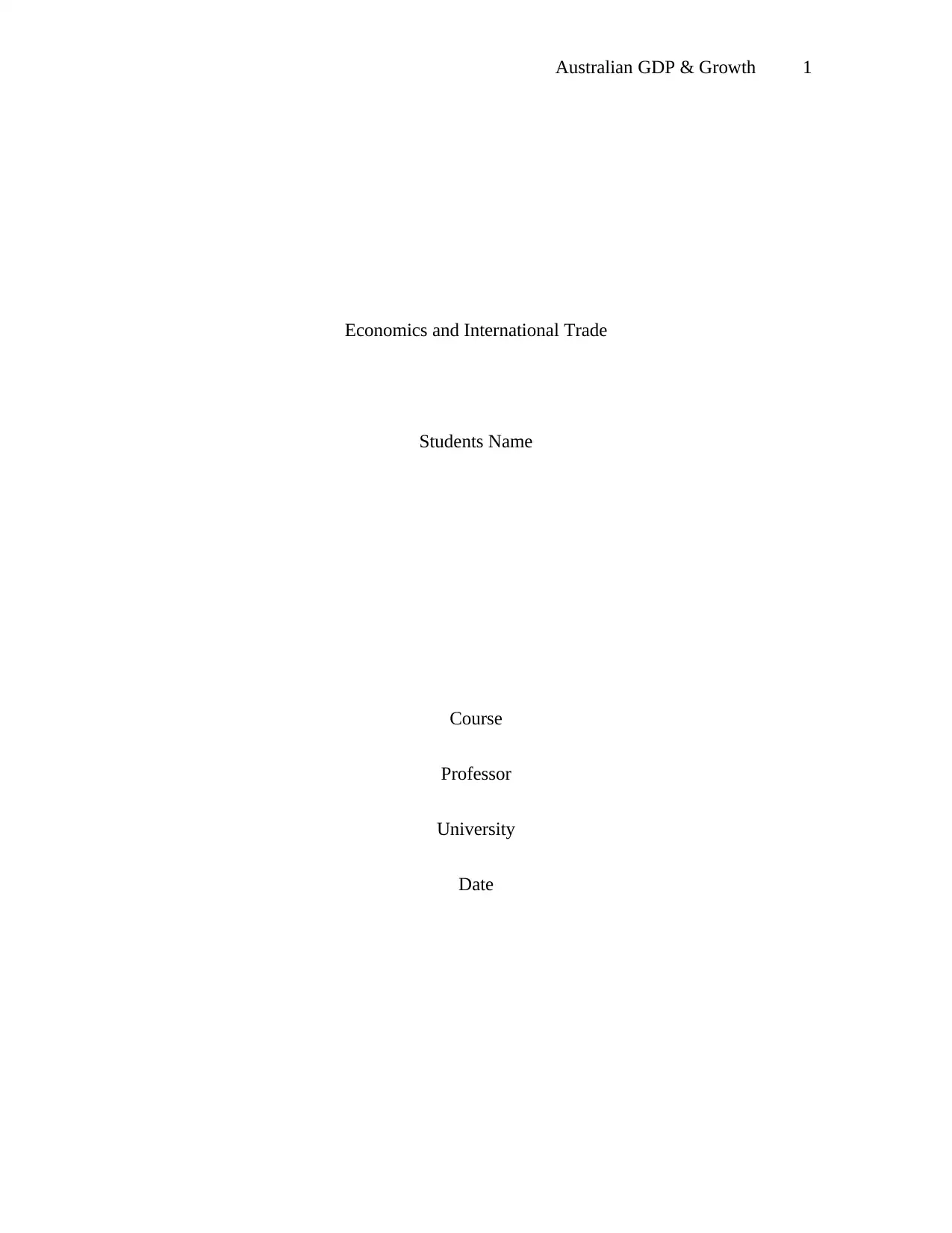
Australian GDP & Growth 1
Economics and International Trade
Students Name
Course
Professor
University
Date
Economics and International Trade
Students Name
Course
Professor
University
Date
Paraphrase This Document
Need a fresh take? Get an instant paraphrase of this document with our AI Paraphraser
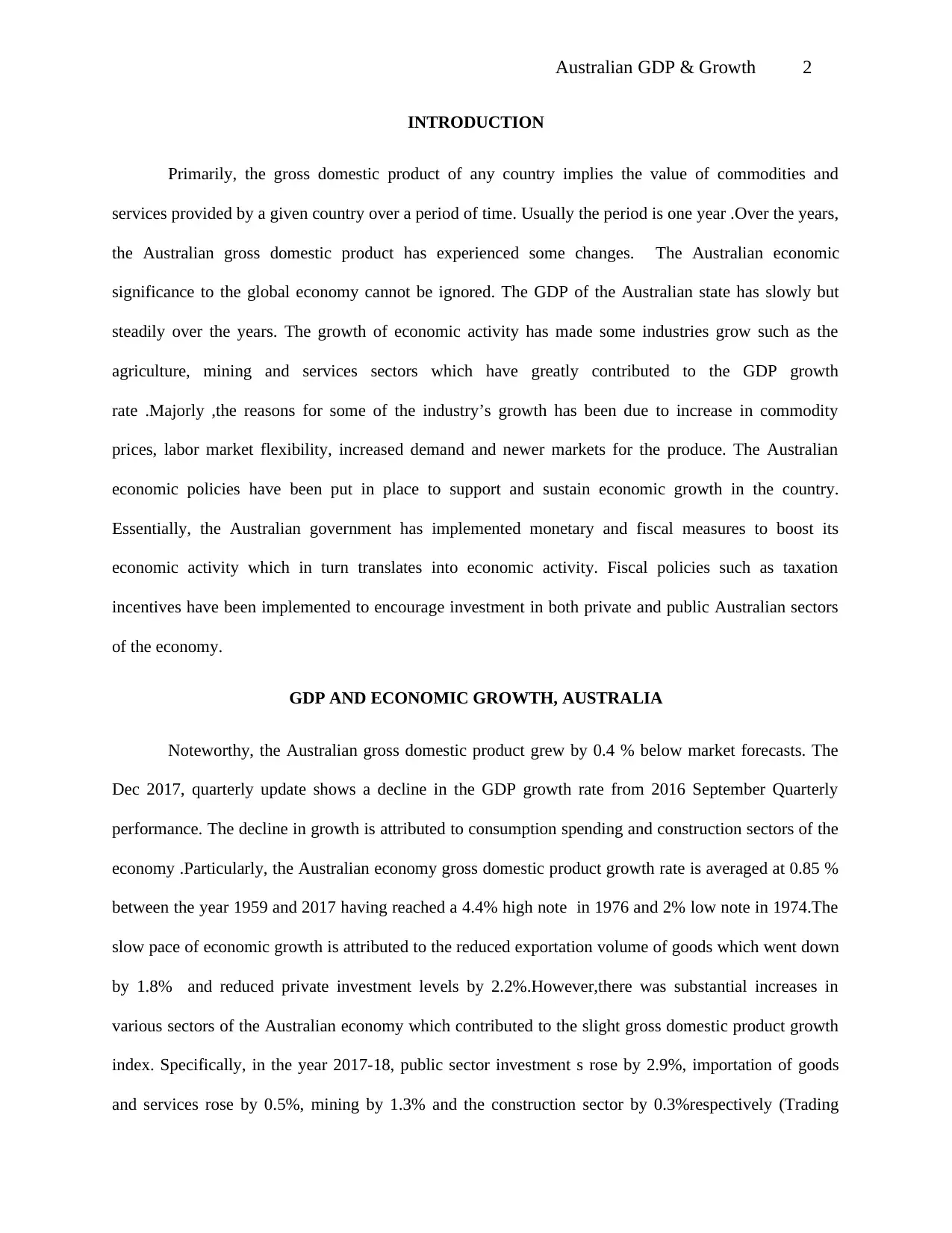
Australian GDP & Growth 2
INTRODUCTION
Primarily, the gross domestic product of any country implies the value of commodities and
services provided by a given country over a period of time. Usually the period is one year .Over the years,
the Australian gross domestic product has experienced some changes. The Australian economic
significance to the global economy cannot be ignored. The GDP of the Australian state has slowly but
steadily over the years. The growth of economic activity has made some industries grow such as the
agriculture, mining and services sectors which have greatly contributed to the GDP growth
rate .Majorly ,the reasons for some of the industry’s growth has been due to increase in commodity
prices, labor market flexibility, increased demand and newer markets for the produce. The Australian
economic policies have been put in place to support and sustain economic growth in the country.
Essentially, the Australian government has implemented monetary and fiscal measures to boost its
economic activity which in turn translates into economic activity. Fiscal policies such as taxation
incentives have been implemented to encourage investment in both private and public Australian sectors
of the economy.
GDP AND ECONOMIC GROWTH, AUSTRALIA
Noteworthy, the Australian gross domestic product grew by 0.4 % below market forecasts. The
Dec 2017, quarterly update shows a decline in the GDP growth rate from 2016 September Quarterly
performance. The decline in growth is attributed to consumption spending and construction sectors of the
economy .Particularly, the Australian economy gross domestic product growth rate is averaged at 0.85 %
between the year 1959 and 2017 having reached a 4.4% high note in 1976 and 2% low note in 1974.The
slow pace of economic growth is attributed to the reduced exportation volume of goods which went down
by 1.8% and reduced private investment levels by 2.2%.However,there was substantial increases in
various sectors of the Australian economy which contributed to the slight gross domestic product growth
index. Specifically, in the year 2017-18, public sector investment s rose by 2.9%, importation of goods
and services rose by 0.5%, mining by 1.3% and the construction sector by 0.3%respectively (Trading
INTRODUCTION
Primarily, the gross domestic product of any country implies the value of commodities and
services provided by a given country over a period of time. Usually the period is one year .Over the years,
the Australian gross domestic product has experienced some changes. The Australian economic
significance to the global economy cannot be ignored. The GDP of the Australian state has slowly but
steadily over the years. The growth of economic activity has made some industries grow such as the
agriculture, mining and services sectors which have greatly contributed to the GDP growth
rate .Majorly ,the reasons for some of the industry’s growth has been due to increase in commodity
prices, labor market flexibility, increased demand and newer markets for the produce. The Australian
economic policies have been put in place to support and sustain economic growth in the country.
Essentially, the Australian government has implemented monetary and fiscal measures to boost its
economic activity which in turn translates into economic activity. Fiscal policies such as taxation
incentives have been implemented to encourage investment in both private and public Australian sectors
of the economy.
GDP AND ECONOMIC GROWTH, AUSTRALIA
Noteworthy, the Australian gross domestic product grew by 0.4 % below market forecasts. The
Dec 2017, quarterly update shows a decline in the GDP growth rate from 2016 September Quarterly
performance. The decline in growth is attributed to consumption spending and construction sectors of the
economy .Particularly, the Australian economy gross domestic product growth rate is averaged at 0.85 %
between the year 1959 and 2017 having reached a 4.4% high note in 1976 and 2% low note in 1974.The
slow pace of economic growth is attributed to the reduced exportation volume of goods which went down
by 1.8% and reduced private investment levels by 2.2%.However,there was substantial increases in
various sectors of the Australian economy which contributed to the slight gross domestic product growth
index. Specifically, in the year 2017-18, public sector investment s rose by 2.9%, importation of goods
and services rose by 0.5%, mining by 1.3% and the construction sector by 0.3%respectively (Trading
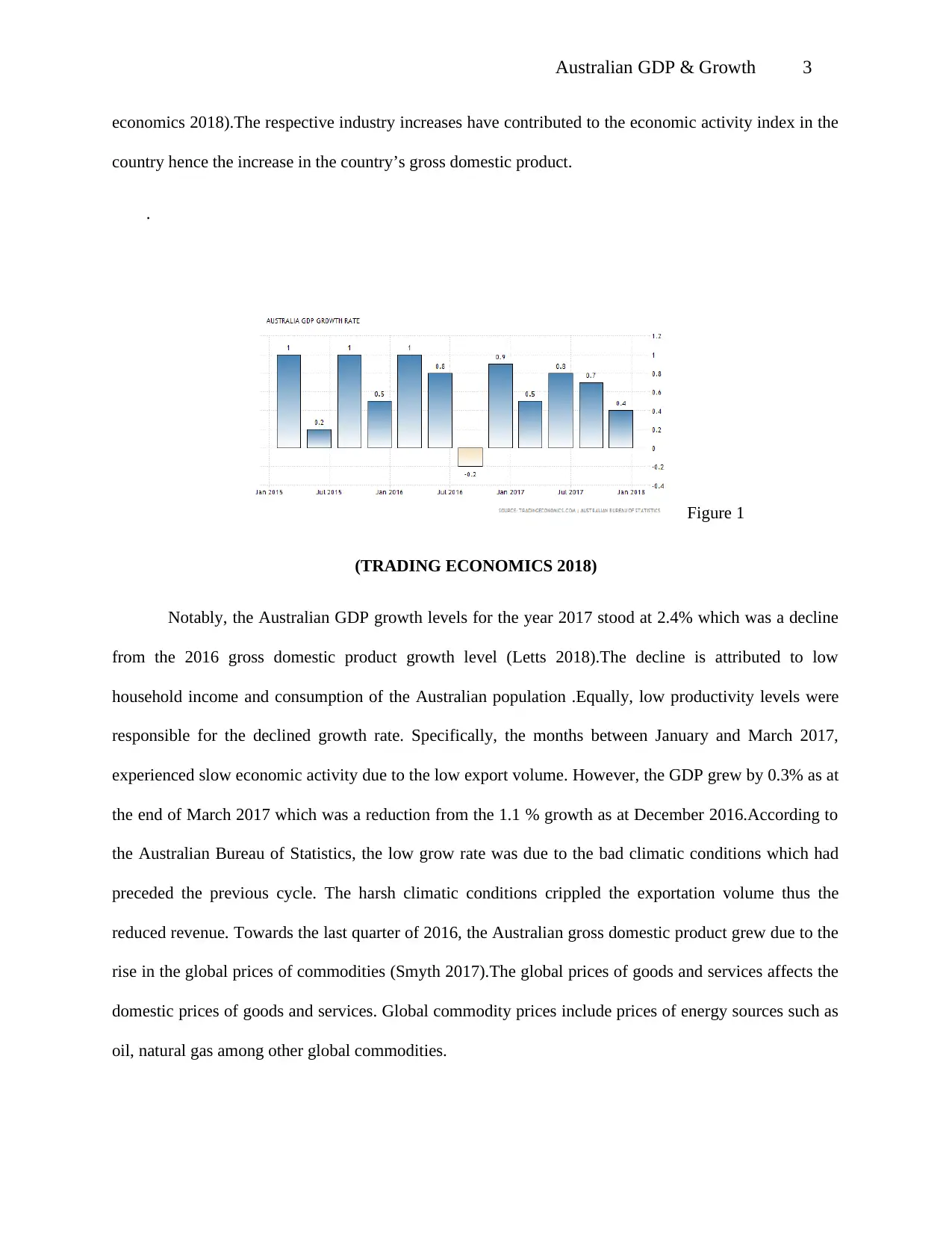
Australian GDP & Growth 3
economics 2018).The respective industry increases have contributed to the economic activity index in the
country hence the increase in the country’s gross domestic product.
.
Figure 1
(TRADING ECONOMICS 2018)
Notably, the Australian GDP growth levels for the year 2017 stood at 2.4% which was a decline
from the 2016 gross domestic product growth level (Letts 2018).The decline is attributed to low
household income and consumption of the Australian population .Equally, low productivity levels were
responsible for the declined growth rate. Specifically, the months between January and March 2017,
experienced slow economic activity due to the low export volume. However, the GDP grew by 0.3% as at
the end of March 2017 which was a reduction from the 1.1 % growth as at December 2016.According to
the Australian Bureau of Statistics, the low grow rate was due to the bad climatic conditions which had
preceded the previous cycle. The harsh climatic conditions crippled the exportation volume thus the
reduced revenue. Towards the last quarter of 2016, the Australian gross domestic product grew due to the
rise in the global prices of commodities (Smyth 2017).The global prices of goods and services affects the
domestic prices of goods and services. Global commodity prices include prices of energy sources such as
oil, natural gas among other global commodities.
economics 2018).The respective industry increases have contributed to the economic activity index in the
country hence the increase in the country’s gross domestic product.
.
Figure 1
(TRADING ECONOMICS 2018)
Notably, the Australian GDP growth levels for the year 2017 stood at 2.4% which was a decline
from the 2016 gross domestic product growth level (Letts 2018).The decline is attributed to low
household income and consumption of the Australian population .Equally, low productivity levels were
responsible for the declined growth rate. Specifically, the months between January and March 2017,
experienced slow economic activity due to the low export volume. However, the GDP grew by 0.3% as at
the end of March 2017 which was a reduction from the 1.1 % growth as at December 2016.According to
the Australian Bureau of Statistics, the low grow rate was due to the bad climatic conditions which had
preceded the previous cycle. The harsh climatic conditions crippled the exportation volume thus the
reduced revenue. Towards the last quarter of 2016, the Australian gross domestic product grew due to the
rise in the global prices of commodities (Smyth 2017).The global prices of goods and services affects the
domestic prices of goods and services. Global commodity prices include prices of energy sources such as
oil, natural gas among other global commodities.
⊘ This is a preview!⊘
Do you want full access?
Subscribe today to unlock all pages.

Trusted by 1+ million students worldwide
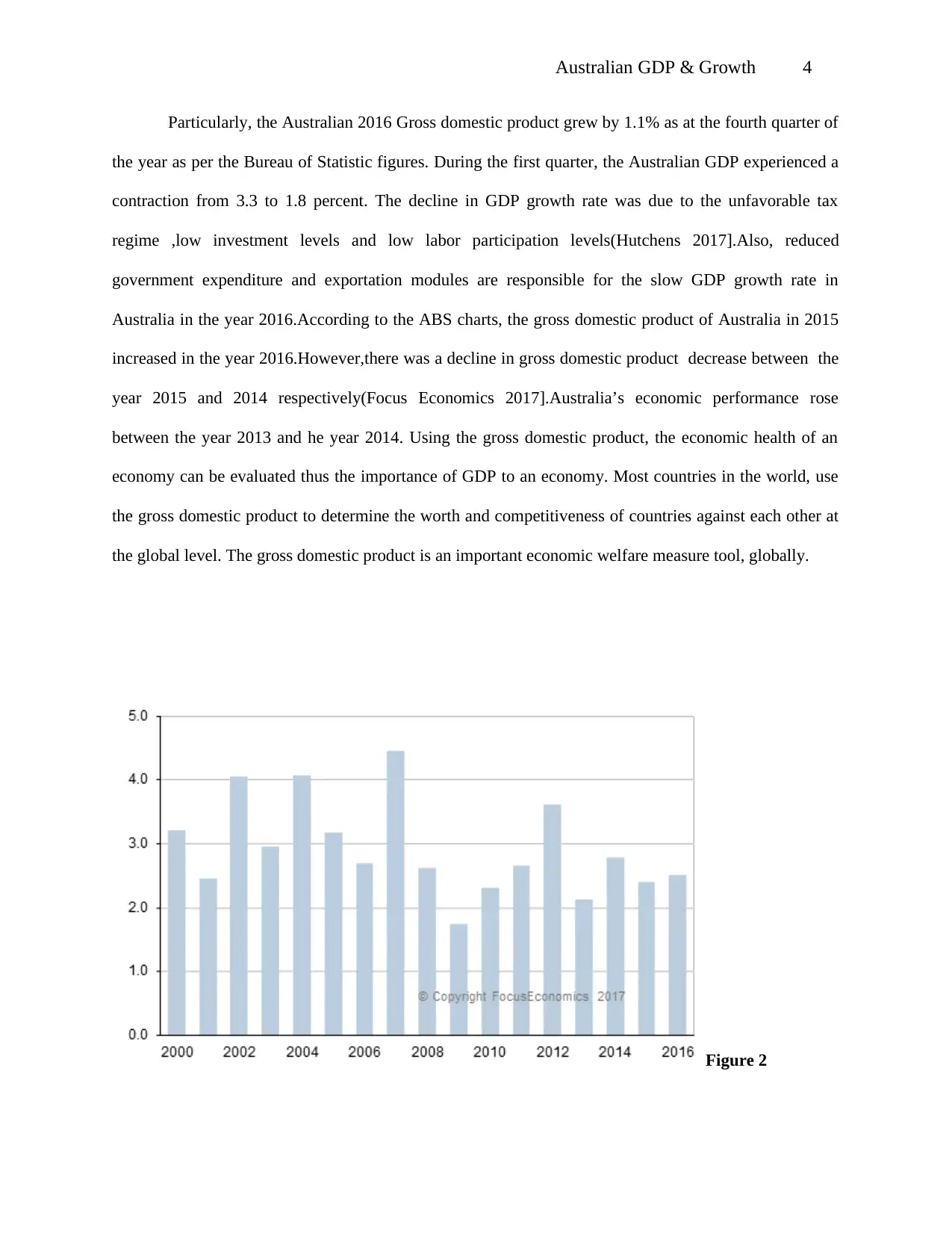
Australian GDP & Growth 4
Particularly, the Australian 2016 Gross domestic product grew by 1.1% as at the fourth quarter of
the year as per the Bureau of Statistic figures. During the first quarter, the Australian GDP experienced a
contraction from 3.3 to 1.8 percent. The decline in GDP growth rate was due to the unfavorable tax
regime ,low investment levels and low labor participation levels(Hutchens 2017].Also, reduced
government expenditure and exportation modules are responsible for the slow GDP growth rate in
Australia in the year 2016.According to the ABS charts, the gross domestic product of Australia in 2015
increased in the year 2016.However,there was a decline in gross domestic product decrease between the
year 2015 and 2014 respectively(Focus Economics 2017].Australia’s economic performance rose
between the year 2013 and he year 2014. Using the gross domestic product, the economic health of an
economy can be evaluated thus the importance of GDP to an economy. Most countries in the world, use
the gross domestic product to determine the worth and competitiveness of countries against each other at
the global level. The gross domestic product is an important economic welfare measure tool, globally.
Figure 2
Particularly, the Australian 2016 Gross domestic product grew by 1.1% as at the fourth quarter of
the year as per the Bureau of Statistic figures. During the first quarter, the Australian GDP experienced a
contraction from 3.3 to 1.8 percent. The decline in GDP growth rate was due to the unfavorable tax
regime ,low investment levels and low labor participation levels(Hutchens 2017].Also, reduced
government expenditure and exportation modules are responsible for the slow GDP growth rate in
Australia in the year 2016.According to the ABS charts, the gross domestic product of Australia in 2015
increased in the year 2016.However,there was a decline in gross domestic product decrease between the
year 2015 and 2014 respectively(Focus Economics 2017].Australia’s economic performance rose
between the year 2013 and he year 2014. Using the gross domestic product, the economic health of an
economy can be evaluated thus the importance of GDP to an economy. Most countries in the world, use
the gross domestic product to determine the worth and competitiveness of countries against each other at
the global level. The gross domestic product is an important economic welfare measure tool, globally.
Figure 2
Paraphrase This Document
Need a fresh take? Get an instant paraphrase of this document with our AI Paraphraser
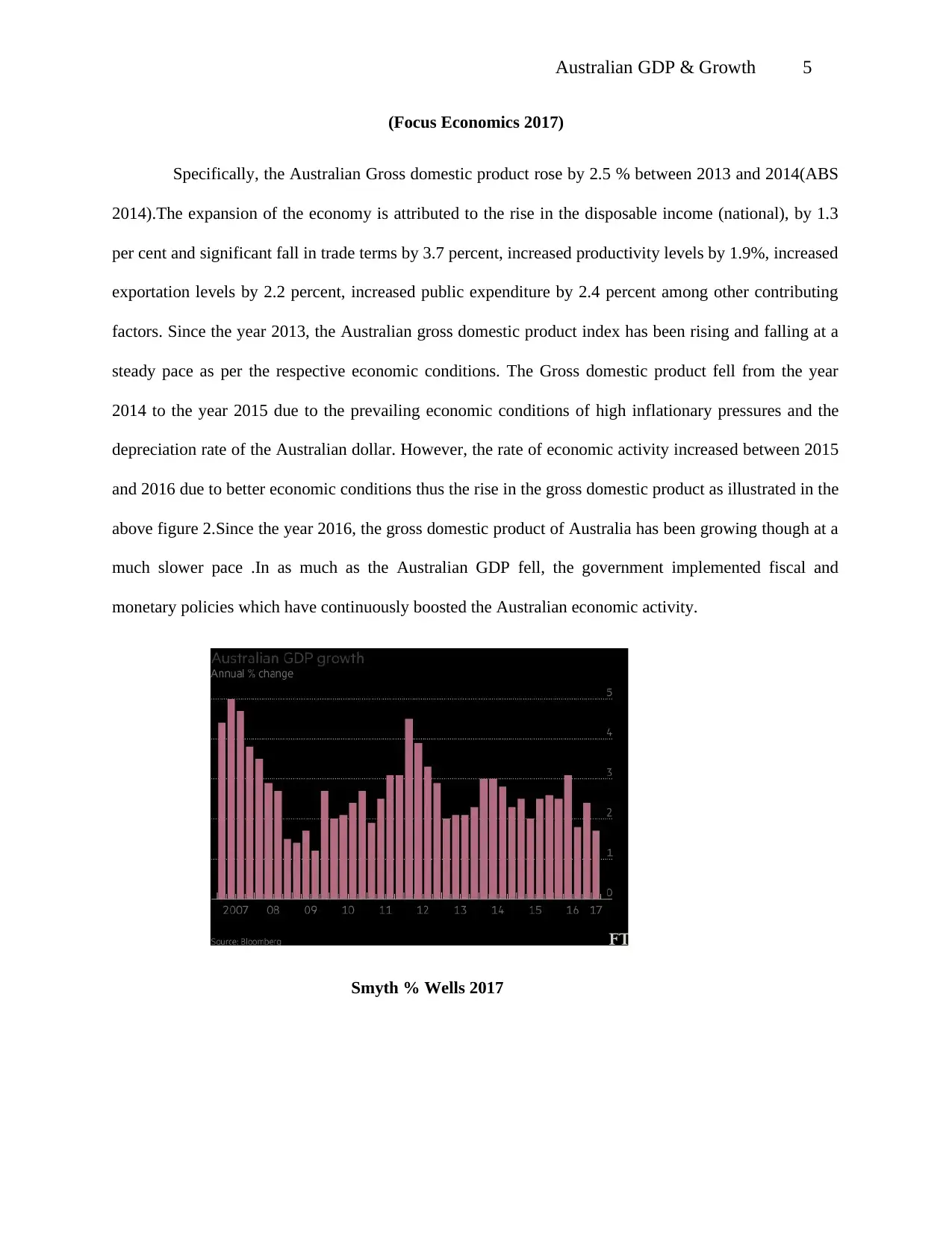
Australian GDP & Growth 5
(Focus Economics 2017)
Specifically, the Australian Gross domestic product rose by 2.5 % between 2013 and 2014(ABS
2014).The expansion of the economy is attributed to the rise in the disposable income (national), by 1.3
per cent and significant fall in trade terms by 3.7 percent, increased productivity levels by 1.9%, increased
exportation levels by 2.2 percent, increased public expenditure by 2.4 percent among other contributing
factors. Since the year 2013, the Australian gross domestic product index has been rising and falling at a
steady pace as per the respective economic conditions. The Gross domestic product fell from the year
2014 to the year 2015 due to the prevailing economic conditions of high inflationary pressures and the
depreciation rate of the Australian dollar. However, the rate of economic activity increased between 2015
and 2016 due to better economic conditions thus the rise in the gross domestic product as illustrated in the
above figure 2.Since the year 2016, the gross domestic product of Australia has been growing though at a
much slower pace .In as much as the Australian GDP fell, the government implemented fiscal and
monetary policies which have continuously boosted the Australian economic activity.
Smyth % Wells 2017
(Focus Economics 2017)
Specifically, the Australian Gross domestic product rose by 2.5 % between 2013 and 2014(ABS
2014).The expansion of the economy is attributed to the rise in the disposable income (national), by 1.3
per cent and significant fall in trade terms by 3.7 percent, increased productivity levels by 1.9%, increased
exportation levels by 2.2 percent, increased public expenditure by 2.4 percent among other contributing
factors. Since the year 2013, the Australian gross domestic product index has been rising and falling at a
steady pace as per the respective economic conditions. The Gross domestic product fell from the year
2014 to the year 2015 due to the prevailing economic conditions of high inflationary pressures and the
depreciation rate of the Australian dollar. However, the rate of economic activity increased between 2015
and 2016 due to better economic conditions thus the rise in the gross domestic product as illustrated in the
above figure 2.Since the year 2016, the gross domestic product of Australia has been growing though at a
much slower pace .In as much as the Australian GDP fell, the government implemented fiscal and
monetary policies which have continuously boosted the Australian economic activity.
Smyth % Wells 2017
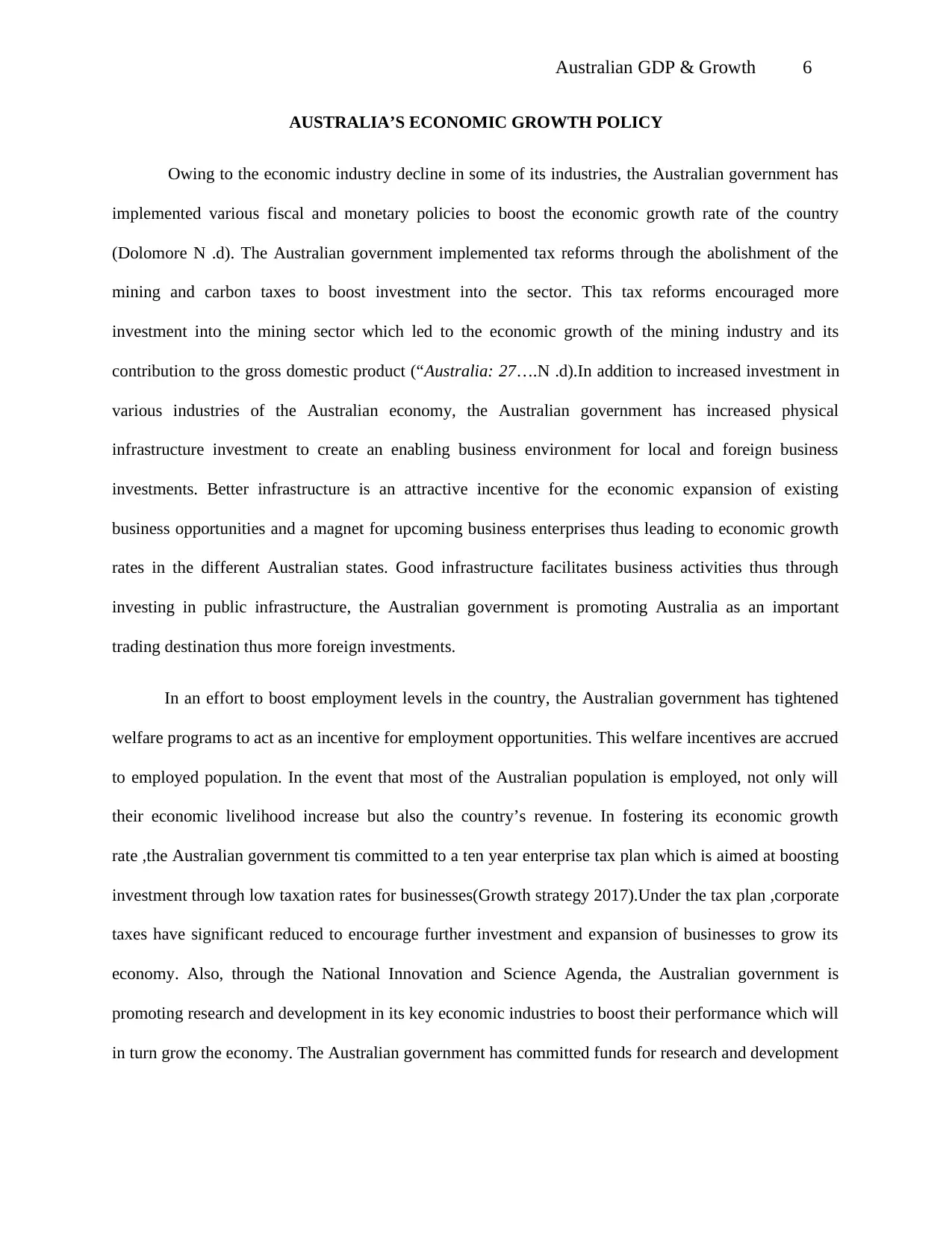
Australian GDP & Growth 6
AUSTRALIA’S ECONOMIC GROWTH POLICY
Owing to the economic industry decline in some of its industries, the Australian government has
implemented various fiscal and monetary policies to boost the economic growth rate of the country
(Dolomore N .d). The Australian government implemented tax reforms through the abolishment of the
mining and carbon taxes to boost investment into the sector. This tax reforms encouraged more
investment into the mining sector which led to the economic growth of the mining industry and its
contribution to the gross domestic product (“Australia: 27….N .d).In addition to increased investment in
various industries of the Australian economy, the Australian government has increased physical
infrastructure investment to create an enabling business environment for local and foreign business
investments. Better infrastructure is an attractive incentive for the economic expansion of existing
business opportunities and a magnet for upcoming business enterprises thus leading to economic growth
rates in the different Australian states. Good infrastructure facilitates business activities thus through
investing in public infrastructure, the Australian government is promoting Australia as an important
trading destination thus more foreign investments.
In an effort to boost employment levels in the country, the Australian government has tightened
welfare programs to act as an incentive for employment opportunities. This welfare incentives are accrued
to employed population. In the event that most of the Australian population is employed, not only will
their economic livelihood increase but also the country’s revenue. In fostering its economic growth
rate ,the Australian government tis committed to a ten year enterprise tax plan which is aimed at boosting
investment through low taxation rates for businesses(Growth strategy 2017).Under the tax plan ,corporate
taxes have significant reduced to encourage further investment and expansion of businesses to grow its
economy. Also, through the National Innovation and Science Agenda, the Australian government is
promoting research and development in its key economic industries to boost their performance which will
in turn grow the economy. The Australian government has committed funds for research and development
AUSTRALIA’S ECONOMIC GROWTH POLICY
Owing to the economic industry decline in some of its industries, the Australian government has
implemented various fiscal and monetary policies to boost the economic growth rate of the country
(Dolomore N .d). The Australian government implemented tax reforms through the abolishment of the
mining and carbon taxes to boost investment into the sector. This tax reforms encouraged more
investment into the mining sector which led to the economic growth of the mining industry and its
contribution to the gross domestic product (“Australia: 27….N .d).In addition to increased investment in
various industries of the Australian economy, the Australian government has increased physical
infrastructure investment to create an enabling business environment for local and foreign business
investments. Better infrastructure is an attractive incentive for the economic expansion of existing
business opportunities and a magnet for upcoming business enterprises thus leading to economic growth
rates in the different Australian states. Good infrastructure facilitates business activities thus through
investing in public infrastructure, the Australian government is promoting Australia as an important
trading destination thus more foreign investments.
In an effort to boost employment levels in the country, the Australian government has tightened
welfare programs to act as an incentive for employment opportunities. This welfare incentives are accrued
to employed population. In the event that most of the Australian population is employed, not only will
their economic livelihood increase but also the country’s revenue. In fostering its economic growth
rate ,the Australian government tis committed to a ten year enterprise tax plan which is aimed at boosting
investment through low taxation rates for businesses(Growth strategy 2017).Under the tax plan ,corporate
taxes have significant reduced to encourage further investment and expansion of businesses to grow its
economy. Also, through the National Innovation and Science Agenda, the Australian government is
promoting research and development in its key economic industries to boost their performance which will
in turn grow the economy. The Australian government has committed funds for research and development
⊘ This is a preview!⊘
Do you want full access?
Subscribe today to unlock all pages.

Trusted by 1+ million students worldwide
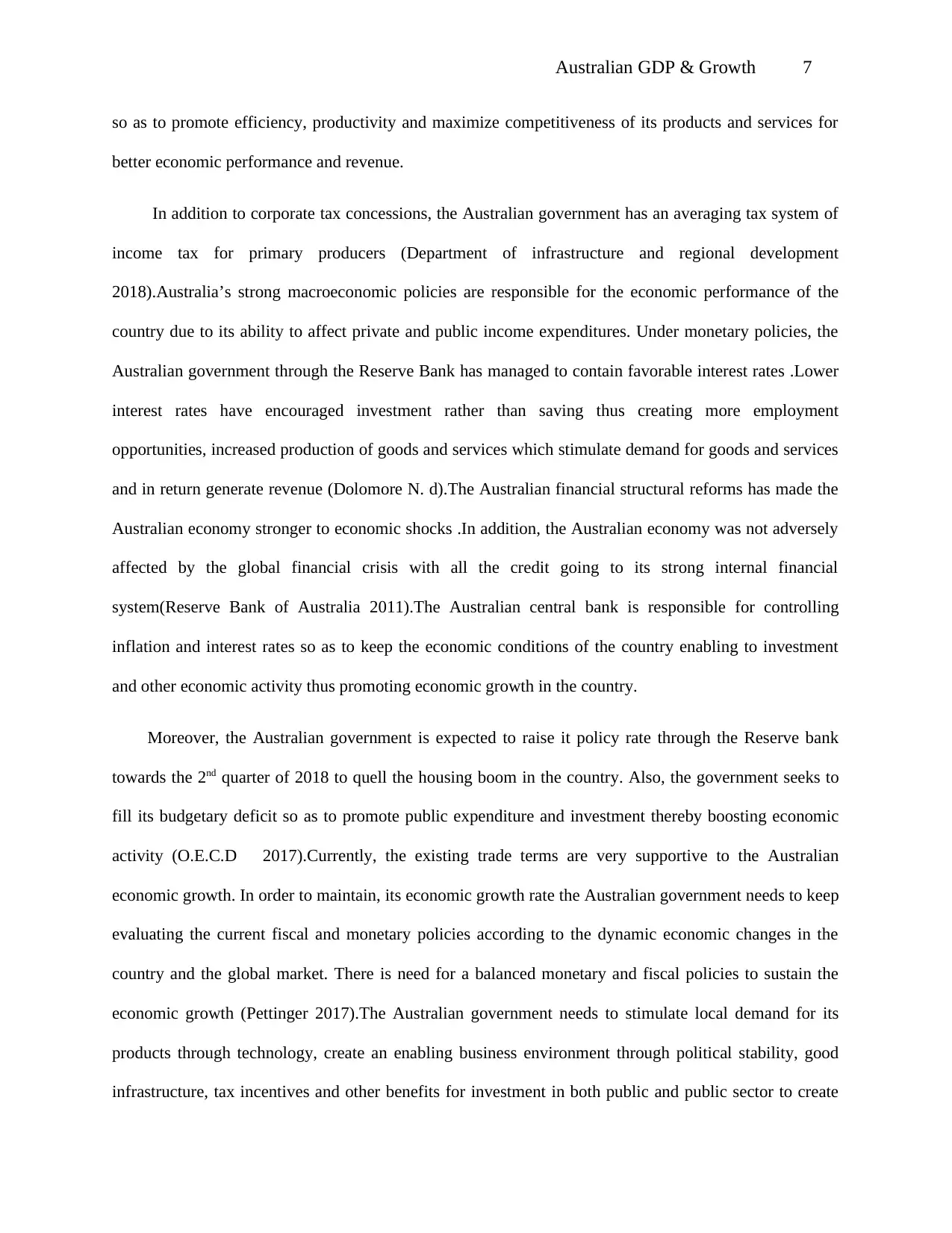
Australian GDP & Growth 7
so as to promote efficiency, productivity and maximize competitiveness of its products and services for
better economic performance and revenue.
In addition to corporate tax concessions, the Australian government has an averaging tax system of
income tax for primary producers (Department of infrastructure and regional development
2018).Australia’s strong macroeconomic policies are responsible for the economic performance of the
country due to its ability to affect private and public income expenditures. Under monetary policies, the
Australian government through the Reserve Bank has managed to contain favorable interest rates .Lower
interest rates have encouraged investment rather than saving thus creating more employment
opportunities, increased production of goods and services which stimulate demand for goods and services
and in return generate revenue (Dolomore N. d).The Australian financial structural reforms has made the
Australian economy stronger to economic shocks .In addition, the Australian economy was not adversely
affected by the global financial crisis with all the credit going to its strong internal financial
system(Reserve Bank of Australia 2011).The Australian central bank is responsible for controlling
inflation and interest rates so as to keep the economic conditions of the country enabling to investment
and other economic activity thus promoting economic growth in the country.
Moreover, the Australian government is expected to raise it policy rate through the Reserve bank
towards the 2nd quarter of 2018 to quell the housing boom in the country. Also, the government seeks to
fill its budgetary deficit so as to promote public expenditure and investment thereby boosting economic
activity (O.E.C.D 2017).Currently, the existing trade terms are very supportive to the Australian
economic growth. In order to maintain, its economic growth rate the Australian government needs to keep
evaluating the current fiscal and monetary policies according to the dynamic economic changes in the
country and the global market. There is need for a balanced monetary and fiscal policies to sustain the
economic growth (Pettinger 2017).The Australian government needs to stimulate local demand for its
products through technology, create an enabling business environment through political stability, good
infrastructure, tax incentives and other benefits for investment in both public and public sector to create
so as to promote efficiency, productivity and maximize competitiveness of its products and services for
better economic performance and revenue.
In addition to corporate tax concessions, the Australian government has an averaging tax system of
income tax for primary producers (Department of infrastructure and regional development
2018).Australia’s strong macroeconomic policies are responsible for the economic performance of the
country due to its ability to affect private and public income expenditures. Under monetary policies, the
Australian government through the Reserve Bank has managed to contain favorable interest rates .Lower
interest rates have encouraged investment rather than saving thus creating more employment
opportunities, increased production of goods and services which stimulate demand for goods and services
and in return generate revenue (Dolomore N. d).The Australian financial structural reforms has made the
Australian economy stronger to economic shocks .In addition, the Australian economy was not adversely
affected by the global financial crisis with all the credit going to its strong internal financial
system(Reserve Bank of Australia 2011).The Australian central bank is responsible for controlling
inflation and interest rates so as to keep the economic conditions of the country enabling to investment
and other economic activity thus promoting economic growth in the country.
Moreover, the Australian government is expected to raise it policy rate through the Reserve bank
towards the 2nd quarter of 2018 to quell the housing boom in the country. Also, the government seeks to
fill its budgetary deficit so as to promote public expenditure and investment thereby boosting economic
activity (O.E.C.D 2017).Currently, the existing trade terms are very supportive to the Australian
economic growth. In order to maintain, its economic growth rate the Australian government needs to keep
evaluating the current fiscal and monetary policies according to the dynamic economic changes in the
country and the global market. There is need for a balanced monetary and fiscal policies to sustain the
economic growth (Pettinger 2017).The Australian government needs to stimulate local demand for its
products through technology, create an enabling business environment through political stability, good
infrastructure, tax incentives and other benefits for investment in both public and public sector to create
Paraphrase This Document
Need a fresh take? Get an instant paraphrase of this document with our AI Paraphraser
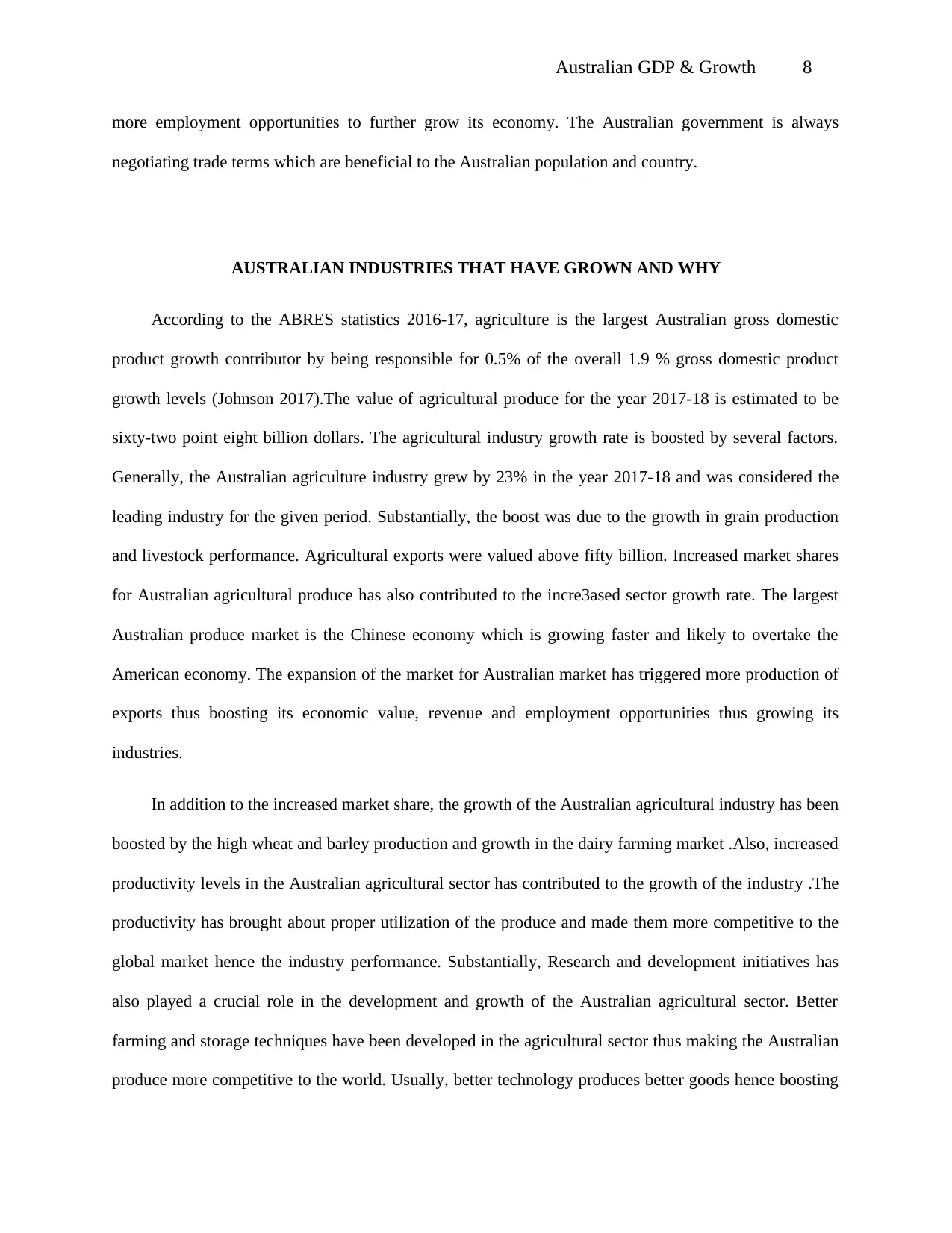
Australian GDP & Growth 8
more employment opportunities to further grow its economy. The Australian government is always
negotiating trade terms which are beneficial to the Australian population and country.
AUSTRALIAN INDUSTRIES THAT HAVE GROWN AND WHY
According to the ABRES statistics 2016-17, agriculture is the largest Australian gross domestic
product growth contributor by being responsible for 0.5% of the overall 1.9 % gross domestic product
growth levels (Johnson 2017).The value of agricultural produce for the year 2017-18 is estimated to be
sixty-two point eight billion dollars. The agricultural industry growth rate is boosted by several factors.
Generally, the Australian agriculture industry grew by 23% in the year 2017-18 and was considered the
leading industry for the given period. Substantially, the boost was due to the growth in grain production
and livestock performance. Agricultural exports were valued above fifty billion. Increased market shares
for Australian agricultural produce has also contributed to the incre3ased sector growth rate. The largest
Australian produce market is the Chinese economy which is growing faster and likely to overtake the
American economy. The expansion of the market for Australian market has triggered more production of
exports thus boosting its economic value, revenue and employment opportunities thus growing its
industries.
In addition to the increased market share, the growth of the Australian agricultural industry has been
boosted by the high wheat and barley production and growth in the dairy farming market .Also, increased
productivity levels in the Australian agricultural sector has contributed to the growth of the industry .The
productivity has brought about proper utilization of the produce and made them more competitive to the
global market hence the industry performance. Substantially, Research and development initiatives has
also played a crucial role in the development and growth of the Australian agricultural sector. Better
farming and storage techniques have been developed in the agricultural sector thus making the Australian
produce more competitive to the world. Usually, better technology produces better goods hence boosting
more employment opportunities to further grow its economy. The Australian government is always
negotiating trade terms which are beneficial to the Australian population and country.
AUSTRALIAN INDUSTRIES THAT HAVE GROWN AND WHY
According to the ABRES statistics 2016-17, agriculture is the largest Australian gross domestic
product growth contributor by being responsible for 0.5% of the overall 1.9 % gross domestic product
growth levels (Johnson 2017).The value of agricultural produce for the year 2017-18 is estimated to be
sixty-two point eight billion dollars. The agricultural industry growth rate is boosted by several factors.
Generally, the Australian agriculture industry grew by 23% in the year 2017-18 and was considered the
leading industry for the given period. Substantially, the boost was due to the growth in grain production
and livestock performance. Agricultural exports were valued above fifty billion. Increased market shares
for Australian agricultural produce has also contributed to the incre3ased sector growth rate. The largest
Australian produce market is the Chinese economy which is growing faster and likely to overtake the
American economy. The expansion of the market for Australian market has triggered more production of
exports thus boosting its economic value, revenue and employment opportunities thus growing its
industries.
In addition to the increased market share, the growth of the Australian agricultural industry has been
boosted by the high wheat and barley production and growth in the dairy farming market .Also, increased
productivity levels in the Australian agricultural sector has contributed to the growth of the industry .The
productivity has brought about proper utilization of the produce and made them more competitive to the
global market hence the industry performance. Substantially, Research and development initiatives has
also played a crucial role in the development and growth of the Australian agricultural sector. Better
farming and storage techniques have been developed in the agricultural sector thus making the Australian
produce more competitive to the world. Usually, better technology produces better goods hence boosting
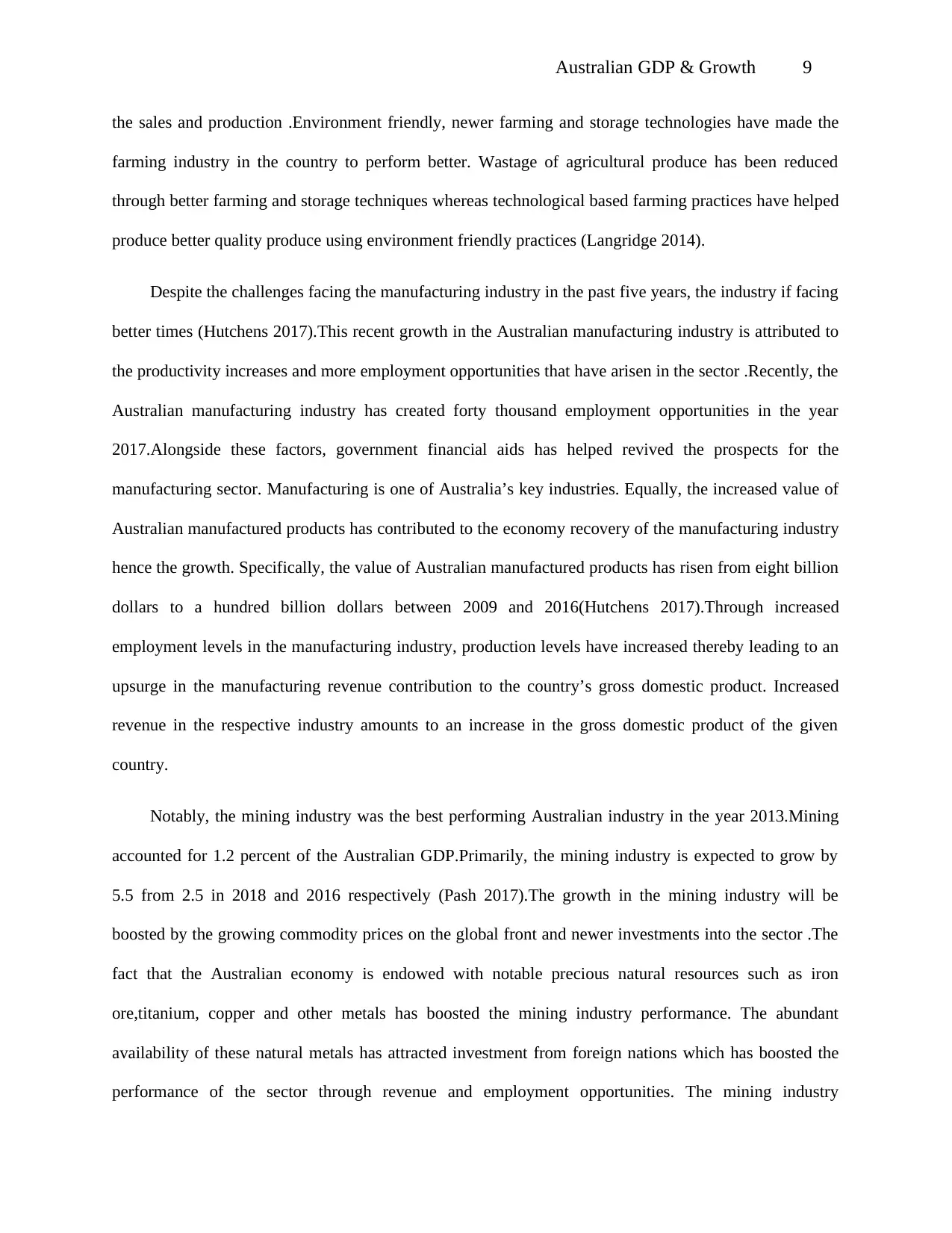
Australian GDP & Growth 9
the sales and production .Environment friendly, newer farming and storage technologies have made the
farming industry in the country to perform better. Wastage of agricultural produce has been reduced
through better farming and storage techniques whereas technological based farming practices have helped
produce better quality produce using environment friendly practices (Langridge 2014).
Despite the challenges facing the manufacturing industry in the past five years, the industry if facing
better times (Hutchens 2017).This recent growth in the Australian manufacturing industry is attributed to
the productivity increases and more employment opportunities that have arisen in the sector .Recently, the
Australian manufacturing industry has created forty thousand employment opportunities in the year
2017.Alongside these factors, government financial aids has helped revived the prospects for the
manufacturing sector. Manufacturing is one of Australia’s key industries. Equally, the increased value of
Australian manufactured products has contributed to the economy recovery of the manufacturing industry
hence the growth. Specifically, the value of Australian manufactured products has risen from eight billion
dollars to a hundred billion dollars between 2009 and 2016(Hutchens 2017).Through increased
employment levels in the manufacturing industry, production levels have increased thereby leading to an
upsurge in the manufacturing revenue contribution to the country’s gross domestic product. Increased
revenue in the respective industry amounts to an increase in the gross domestic product of the given
country.
Notably, the mining industry was the best performing Australian industry in the year 2013.Mining
accounted for 1.2 percent of the Australian GDP.Primarily, the mining industry is expected to grow by
5.5 from 2.5 in 2018 and 2016 respectively (Pash 2017).The growth in the mining industry will be
boosted by the growing commodity prices on the global front and newer investments into the sector .The
fact that the Australian economy is endowed with notable precious natural resources such as iron
ore,titanium, copper and other metals has boosted the mining industry performance. The abundant
availability of these natural metals has attracted investment from foreign nations which has boosted the
performance of the sector through revenue and employment opportunities. The mining industry
the sales and production .Environment friendly, newer farming and storage technologies have made the
farming industry in the country to perform better. Wastage of agricultural produce has been reduced
through better farming and storage techniques whereas technological based farming practices have helped
produce better quality produce using environment friendly practices (Langridge 2014).
Despite the challenges facing the manufacturing industry in the past five years, the industry if facing
better times (Hutchens 2017).This recent growth in the Australian manufacturing industry is attributed to
the productivity increases and more employment opportunities that have arisen in the sector .Recently, the
Australian manufacturing industry has created forty thousand employment opportunities in the year
2017.Alongside these factors, government financial aids has helped revived the prospects for the
manufacturing sector. Manufacturing is one of Australia’s key industries. Equally, the increased value of
Australian manufactured products has contributed to the economy recovery of the manufacturing industry
hence the growth. Specifically, the value of Australian manufactured products has risen from eight billion
dollars to a hundred billion dollars between 2009 and 2016(Hutchens 2017).Through increased
employment levels in the manufacturing industry, production levels have increased thereby leading to an
upsurge in the manufacturing revenue contribution to the country’s gross domestic product. Increased
revenue in the respective industry amounts to an increase in the gross domestic product of the given
country.
Notably, the mining industry was the best performing Australian industry in the year 2013.Mining
accounted for 1.2 percent of the Australian GDP.Primarily, the mining industry is expected to grow by
5.5 from 2.5 in 2018 and 2016 respectively (Pash 2017).The growth in the mining industry will be
boosted by the growing commodity prices on the global front and newer investments into the sector .The
fact that the Australian economy is endowed with notable precious natural resources such as iron
ore,titanium, copper and other metals has boosted the mining industry performance. The abundant
availability of these natural metals has attracted investment from foreign nations which has boosted the
performance of the sector through revenue and employment opportunities. The mining industry
⊘ This is a preview!⊘
Do you want full access?
Subscribe today to unlock all pages.

Trusted by 1+ million students worldwide
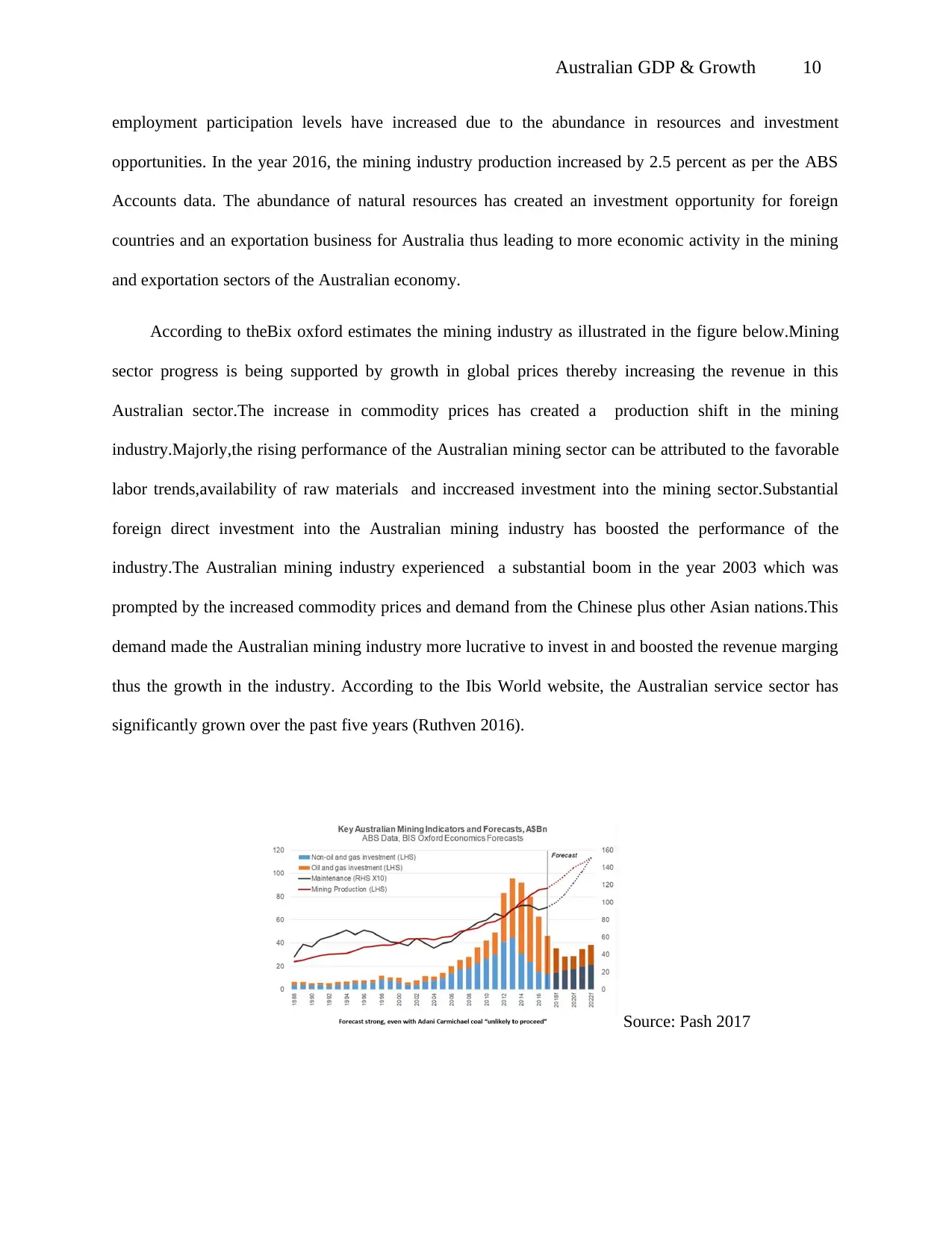
Australian GDP & Growth 10
employment participation levels have increased due to the abundance in resources and investment
opportunities. In the year 2016, the mining industry production increased by 2.5 percent as per the ABS
Accounts data. The abundance of natural resources has created an investment opportunity for foreign
countries and an exportation business for Australia thus leading to more economic activity in the mining
and exportation sectors of the Australian economy.
According to theBix oxford estimates the mining industry as illustrated in the figure below.Mining
sector progress is being supported by growth in global prices thereby increasing the revenue in this
Australian sector.The increase in commodity prices has created a production shift in the mining
industry.Majorly,the rising performance of the Australian mining sector can be attributed to the favorable
labor trends,availability of raw materials and inccreased investment into the mining sector.Substantial
foreign direct investment into the Australian mining industry has boosted the performance of the
industry.The Australian mining industry experienced a substantial boom in the year 2003 which was
prompted by the increased commodity prices and demand from the Chinese plus other Asian nations.This
demand made the Australian mining industry more lucrative to invest in and boosted the revenue marging
thus the growth in the industry. According to the Ibis World website, the Australian service sector has
significantly grown over the past five years (Ruthven 2016).
Source: Pash 2017
employment participation levels have increased due to the abundance in resources and investment
opportunities. In the year 2016, the mining industry production increased by 2.5 percent as per the ABS
Accounts data. The abundance of natural resources has created an investment opportunity for foreign
countries and an exportation business for Australia thus leading to more economic activity in the mining
and exportation sectors of the Australian economy.
According to theBix oxford estimates the mining industry as illustrated in the figure below.Mining
sector progress is being supported by growth in global prices thereby increasing the revenue in this
Australian sector.The increase in commodity prices has created a production shift in the mining
industry.Majorly,the rising performance of the Australian mining sector can be attributed to the favorable
labor trends,availability of raw materials and inccreased investment into the mining sector.Substantial
foreign direct investment into the Australian mining industry has boosted the performance of the
industry.The Australian mining industry experienced a substantial boom in the year 2003 which was
prompted by the increased commodity prices and demand from the Chinese plus other Asian nations.This
demand made the Australian mining industry more lucrative to invest in and boosted the revenue marging
thus the growth in the industry. According to the Ibis World website, the Australian service sector has
significantly grown over the past five years (Ruthven 2016).
Source: Pash 2017
Paraphrase This Document
Need a fresh take? Get an instant paraphrase of this document with our AI Paraphraser
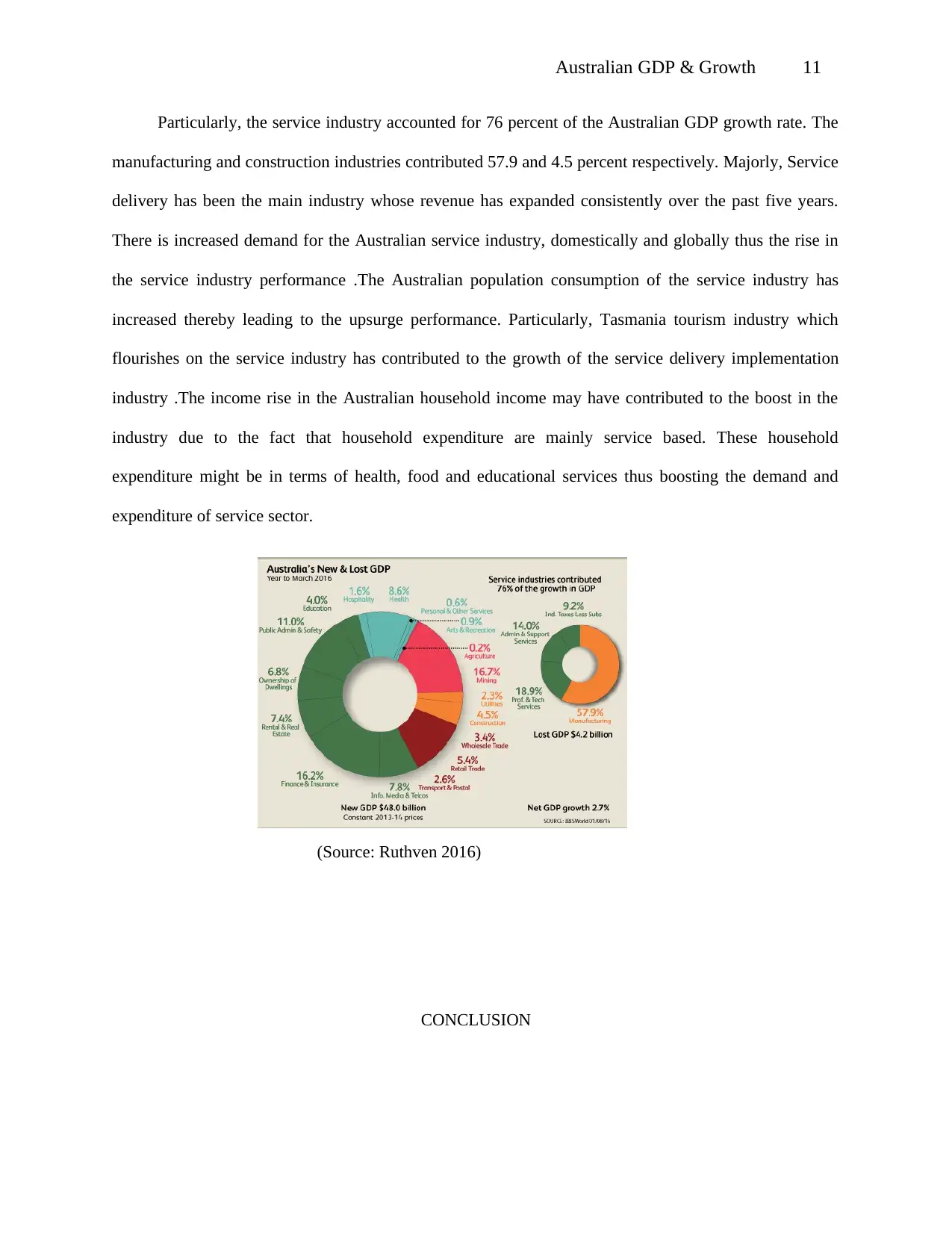
Australian GDP & Growth 11
Particularly, the service industry accounted for 76 percent of the Australian GDP growth rate. The
manufacturing and construction industries contributed 57.9 and 4.5 percent respectively. Majorly, Service
delivery has been the main industry whose revenue has expanded consistently over the past five years.
There is increased demand for the Australian service industry, domestically and globally thus the rise in
the service industry performance .The Australian population consumption of the service industry has
increased thereby leading to the upsurge performance. Particularly, Tasmania tourism industry which
flourishes on the service industry has contributed to the growth of the service delivery implementation
industry .The income rise in the Australian household income may have contributed to the boost in the
industry due to the fact that household expenditure are mainly service based. These household
expenditure might be in terms of health, food and educational services thus boosting the demand and
expenditure of service sector.
(Source: Ruthven 2016)
CONCLUSION
Particularly, the service industry accounted for 76 percent of the Australian GDP growth rate. The
manufacturing and construction industries contributed 57.9 and 4.5 percent respectively. Majorly, Service
delivery has been the main industry whose revenue has expanded consistently over the past five years.
There is increased demand for the Australian service industry, domestically and globally thus the rise in
the service industry performance .The Australian population consumption of the service industry has
increased thereby leading to the upsurge performance. Particularly, Tasmania tourism industry which
flourishes on the service industry has contributed to the growth of the service delivery implementation
industry .The income rise in the Australian household income may have contributed to the boost in the
industry due to the fact that household expenditure are mainly service based. These household
expenditure might be in terms of health, food and educational services thus boosting the demand and
expenditure of service sector.
(Source: Ruthven 2016)
CONCLUSION
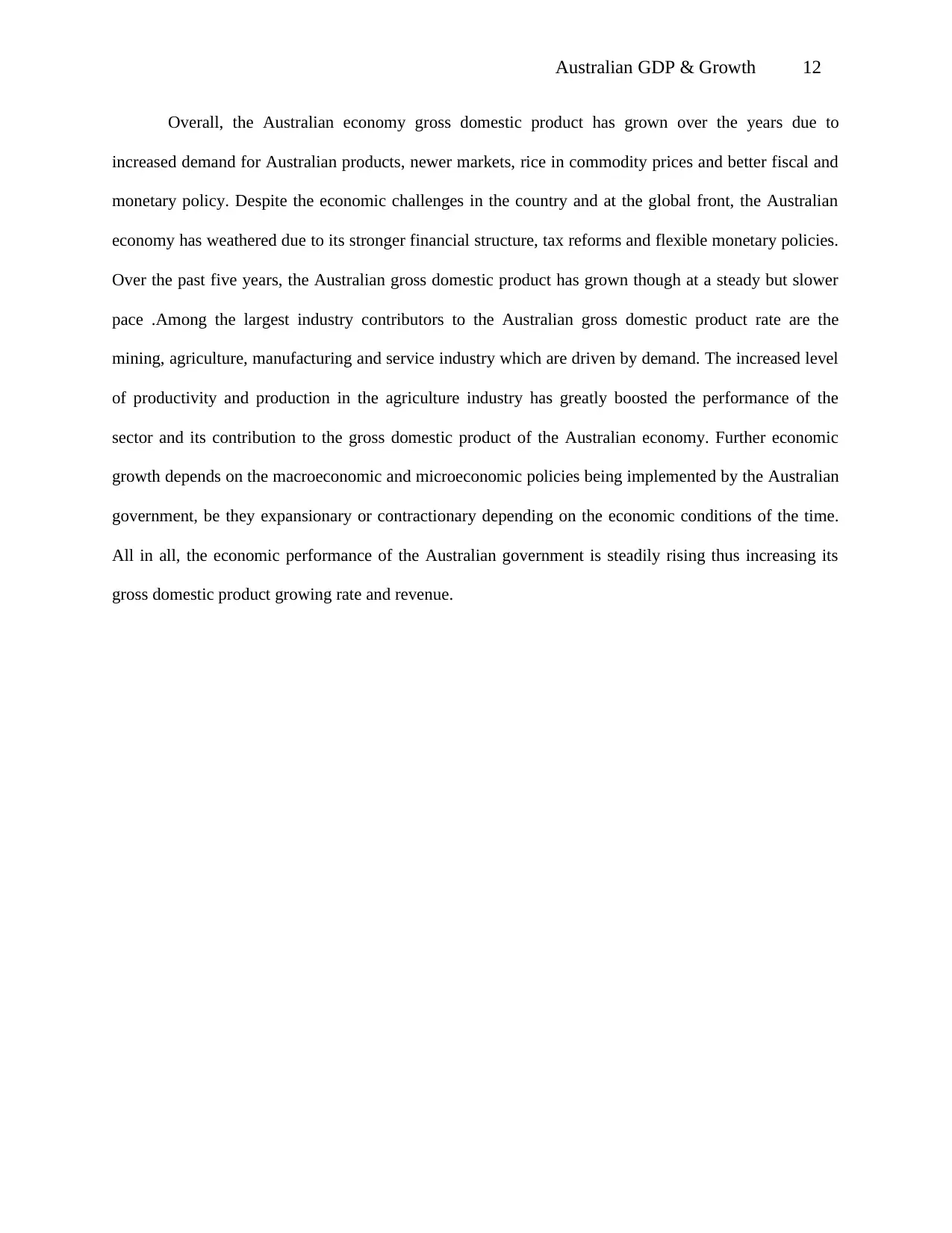
Australian GDP & Growth 12
Overall, the Australian economy gross domestic product has grown over the years due to
increased demand for Australian products, newer markets, rice in commodity prices and better fiscal and
monetary policy. Despite the economic challenges in the country and at the global front, the Australian
economy has weathered due to its stronger financial structure, tax reforms and flexible monetary policies.
Over the past five years, the Australian gross domestic product has grown though at a steady but slower
pace .Among the largest industry contributors to the Australian gross domestic product rate are the
mining, agriculture, manufacturing and service industry which are driven by demand. The increased level
of productivity and production in the agriculture industry has greatly boosted the performance of the
sector and its contribution to the gross domestic product of the Australian economy. Further economic
growth depends on the macroeconomic and microeconomic policies being implemented by the Australian
government, be they expansionary or contractionary depending on the economic conditions of the time.
All in all, the economic performance of the Australian government is steadily rising thus increasing its
gross domestic product growing rate and revenue.
Overall, the Australian economy gross domestic product has grown over the years due to
increased demand for Australian products, newer markets, rice in commodity prices and better fiscal and
monetary policy. Despite the economic challenges in the country and at the global front, the Australian
economy has weathered due to its stronger financial structure, tax reforms and flexible monetary policies.
Over the past five years, the Australian gross domestic product has grown though at a steady but slower
pace .Among the largest industry contributors to the Australian gross domestic product rate are the
mining, agriculture, manufacturing and service industry which are driven by demand. The increased level
of productivity and production in the agriculture industry has greatly boosted the performance of the
sector and its contribution to the gross domestic product of the Australian economy. Further economic
growth depends on the macroeconomic and microeconomic policies being implemented by the Australian
government, be they expansionary or contractionary depending on the economic conditions of the time.
All in all, the economic performance of the Australian government is steadily rising thus increasing its
gross domestic product growing rate and revenue.
⊘ This is a preview!⊘
Do you want full access?
Subscribe today to unlock all pages.

Trusted by 1+ million students worldwide
1 out of 15
Related Documents
Your All-in-One AI-Powered Toolkit for Academic Success.
+13062052269
info@desklib.com
Available 24*7 on WhatsApp / Email
![[object Object]](/_next/static/media/star-bottom.7253800d.svg)
Unlock your academic potential
Copyright © 2020–2025 A2Z Services. All Rights Reserved. Developed and managed by ZUCOL.





